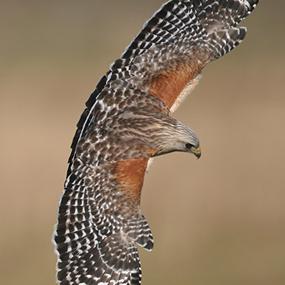For "Winged Wednesday":
O'ahu ʻElepaioFrom Rare Powers to Rare Species:
.jpg)

The diminutive ʻElepaio (pronounced “el-a-pie-o”) had remarkable powers, according to native Hawaiians. Canoe-builders considered the bird an incarnation of their patron goddess Lea: If the bird pecked at a fallen koa tree, it was a sign that the tree was riddled with insects and unusable for boat-building. Farmers believed that this insectivorous bird was the incarnation of Lea's sister goddess, Hina-pukuʻai, a patron of agriculture.
This bold and adaptable bird may indeed follow people when they enter its forest habitat, and quickly learns to exploit feeding opportunities created by human activity. Unfortunately, the Oʻahu ‘Elepaio—an Old World monarch flycatcher—is in serious decline on its native island, where it was once among the most common land birds. Declines have been so severe that the species is listed as Endangered under the U.S. Endangered Species Act. It is also a U.S. WatchList species.
More than half of the O’ahu ‘Elepaio’s former range has been converted to agriculture or urban development. Fires also threaten the remaining suitable habitat. Mosquito-borne diseases such as avian pox and malaria are a problem throughout its range. (Learn more about Hawaiʻi, the bird extinction capital of the world.)
Nest predation by black rats is the most serious current problem, although rat-control efforts have been locally effective at stabilizing the bird’s population. Recent research shows that Oʻahu ‘Elepaio in some areas are evolving in response to rat predation by building their nests higher off the ground."
For millenia, the ‘Elepaio has been a part of the Hawaiian landscape. You can help keep the ‘Elepaio in the picture by joining ABC’s “Keep Birds in the Picture” Challenge. A dollar-for-dollar match will double the value of your gift received by Dec. 31, 2013.
______
California solar power plants singeing bird feathers

A 459-foot solar tower, surrounded by thousands of reflecting mirrors, is one of three towers about to go online at BrightSource Energy's Ivanpah solar project in east San Bernardino County.(Photo: The (Palm Springs, Calif.) Desert Sun)
At the moment, Ivanpah -- now in the testing stage -- is the largest solar thermal plant in the world.

"A migrating bird has to be in top form, having the flight feathers in really good shape," said ornithology collections manager Kimball L. Garrett of the Museum of Natural History of Los Angeles County, who has not seen the picture from Ivanpah but has been concerned about bird deaths at large solar projects.
"If some of its flight feathers are damaged, what does that mean for the rest of the bird's migration?" he said. "It weakens feathers. These are things people don't study because — how can you?"
Trying to estimate how many birds could be injured or killed because of large-scale solar projects and what might be done to prevent deaths has become a pressing concern for solar developers and environmental agencies as these projects multiply. Developers hope to have the Palen project online in 2016." More and video at: http://www.usatoday.com/story/news/nation/2013/11/10/bird-feathers-singed-solar-power/3491617
______
Threat to migrating birds puts spotlight on Bob Kerrey bridge

So, federal wildlife officials have asked the city to turn off all but essential bridge lights from April 15 through May 31 and Sept. 1 through Oct. 31.
Earlier in the week the U.S. Fish and Wildlife Service notified Bench of its concern that the bridge lights could be claiming the lives of night-migrating birds.
Robert Harms, a wildlife biologist with the service, said many birds migrate at night and can become disoriented by bright lights. Birds at risk include robins, warblers, herons, cranes, geese and sandpipers.
Federal law protects migrating birds from direct and indirect threats, Harms said. Common indirect threats are things such as city lights, power lines and guy wires.
Harms said no bird carcasses have been found on the bridge that links Omaha and Council Bluffs, but that it's likely birds are falling into the Missouri River." More at: http://www.omaha.com/article/20131104/NEWS/131109503
______
Wisconsin's 2011 Blow-Down Area Provides Benefits for Imperiled Species
Storm Left Counties Buried in Wood but Created a Home for Declining Warbler

“Generally, most people saw the blow-down as massively destructive,” said Wisconsin DNR Wildlife Biologist Bob Hanson. “However, with the correct management prescription, it actually has provided some great habitat for this potentially endangered species. The shotgun pattern the storm left created new areas of young forest, a requirement of the Golden-winged Warbler.”" More at: http://www.abcbirds.org/newsandreports/releases/131030.html
______
Displaying Raggiana Bird of Paradise
"Wow, the Birds of Paradise ... a family of superlatives. Cornell and National Geographic led an unprecedented multi-year expedition to film all 39 species. Check out this Raggiana Bird of Paradise, the star of Friday's show, as he struts his stuff >>
______
BirdNote: Fairywrens and Birds of Paradise!
Upcoming Shows
Red-backed Fairywren SUNDAY Speciation and Biodiversity Featuring Dr. Mike Webster, Director of the Macaulay Library, Cornell Lab of Ornithology LISTEN NOW ►
Spectacled Eider MONDAY Dive in the Ice in Winter by Todd Peterson LISTEN NOW ►
Red-shouldered Hawk TUESDAY One Gorgeous Bird of Prey by Bob Sundstrom LISTEN NOW ►
Green-winged Teal WEDNESDAY Fancy Ducks by Bob Sundstrom LISTEN NOW ►
THURSDAY The Importance Of The Yellow Sea To Migratory Birds Featuring Nils Warnock Ph.D., Director Audubon Alaska LISTEN NOW ►
Raggiana Bird of Paradise FRIDAY Birds of Paradise by Bob Sundstrom LISTEN NOW ►
American Crow SATURDAY Crows and Chips by Ellen Blackstone LISTEN
______
On This Day:
Blacksnake Hills trading post is renamed St. Joseph, Nov 20, 1843:
"Established as the Blacksnake Hills trading post in 1826, the growing community along the banks of the Missouri River adopts the more impressive St. Joseph as its name.

Although the fur trade declined after the 1830s, the town nonetheless prospered and continued to grow as a popular gateway to the West for overland travelers. No longer a mere trading post, the city leaders decided their little town needed a more impressive title than Blacksnake Hills and renamed it St. Joseph.
The number of overland emigrants picking St. Joseph as a rendezvous spot and jumping-off point for their 
By 1859, St. Joseph was the second largest city in Missouri, surpassed only by St. Louis. With the arrival of the railroad that same year, St. Joseph became the eastern terminus of the short-lived Pony Express, which picked up mail delivered by train to St. Joseph and brought it by horseback to California from 1860 to 1861.
After the Civil War, Kansas City began to eclipse St. Joseph as the major western travel hub and crossroad for western emigrants. Its proximity to the southern cattle trails and Hannibal Bridge across the Missouri, which eliminated the need for ferries, made it a more attractive stop than St. Joseph."
______
Nuremberg trials begin, Nov 20, 1945:

On October 16, 10 of the architects of Nazi policy were hanged. Goering, who at sentencing was called the "leading war aggressor and creator of the oppressive program against the Jews," committed suicide by poison on the eve of his scheduled execution. Nazi Party leader Martin Bormann was condemned to death in absentia (but is now believed to have died in May 1945). Trials of lesser German and Axis war criminals continued in Germany into the 1950s and resulted in the conviction of 5,025 other defendants and the execution of 806."
______
Yesterday:
Ray and I started late, but we got something important done. We needed some of that 1/2" x 1/2" wire fencing to 
But all that galvanized roofing that came off the old RVport was on top of the wire mesh. So we moved all the galvanized roofing onto my flatbed trailer, and listed it on Craigslist and www.bookoo.com . By the time we had it stacked, in size order, we were done. Already, I have had a reply to the ad today.























No comments:
Post a Comment